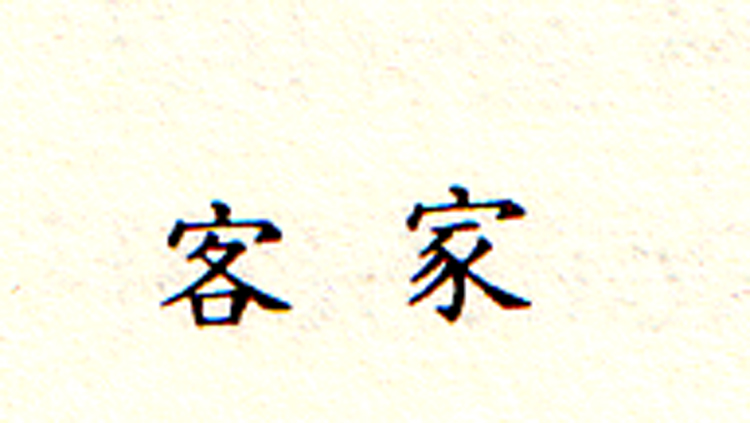|
Read 13362328 times
Connect me to:
|
Hakka FoodChinese Food in China, Hong Kong, and/or Taiwan
Winter Volume: 2007 Issue: 14(4) page(s): 32, 33, and 35
 An article about the Chinese 'guest people' known as the Hakka did appear some years ago in Volume 10(4) on pages 5, 26, and 34. However, it seems that many questions remain. Who the Hakka actually are remains a puzzle even to those who study them. Furthermore, few know about the foods of this once nomadic group, and they want more recipes. They also want to see the word 'Hakka' in Chinese in order to ask for their food; it is on this page. An article about the Chinese 'guest people' known as the Hakka did appear some years ago in Volume 10(4) on pages 5, 26, and 34. However, it seems that many questions remain. Who the Hakka actually are remains a puzzle even to those who study them. Furthermore, few know about the foods of this once nomadic group, and they want more recipes. They also want to see the word 'Hakka' in Chinese in order to ask for their food; it is on this page.
Recent records indicate many migrations. An early and popular one showed that the Hakka originated in Northern China in the Shandong region circa 300 CE. However, additional research showed earlier reports about Hakka circa 250 BCE. All of the reports we read said they were in the Shandong, Shanxi, and Anwei regions. During the Northern and Southern dynastic periods (420 - 589 CE), there was a large southern migration, perhaps not the first. Reasons given for their movement southward include persecution. These people, also known as the Ke jia in the Fujianese dialect, moved southward often and over time. They continued to settle into the province of Guangdong, and did so again during the Five Dynasties period (900 - 960 CE). Some then also moved to Fujian. Later there were more attacks, larger ones, and this time by the Mongols,(circa the 14th century). By this time, many Hakka who remained either perished or joined their brethren in the south. Later still, there were more attacks, such as those during the Taiping Rebellion. More and more Hakka moved during the Qing Dynasty (1611 - 1911CE). For the most part, they stayed in these provinces, though some did cross the Straits of Taiwan. Before, then, and later, others also moved to Indonesia and to many other places. Today, many Hakka live in the Guangdong, Guangxi, Zhekiang, and Jiangsu provinces, and elsewhere. Where and whenever they moved, they took their food favorites with them. One of these is their love for preserved vegetables. The article mentioned above had a recipe for Preserved Pork. It also had five other favorite foods. The Hakka love organ meats such as tripe and stuffed tofu, the latter particularly in soups; and everyone knows they love Salt-baked Chicken. Some refer to that dish as Beggars Chicken. There is recipe with that name that appeared in Volume 5(2) and it is on the website www.flavorandfortune.com Perhaps it was lack of clarifications that triggered most correspondence. There were many requests for twice-cooked braised pork prepared, particularly one made with bean curd. This article hopes to correct some of these and others. These wanderers moved because they were ousted by Tartars and others who wanted their land and did not want them. They had lived in round ancestral homes and in ordinary ones. They built similar ones in the western Fujianese villages of Taining, Ninghua, and Yongling. They moved to attached-type homes in Taiwan where they are now the second largest ethnic group after the Fujianese (sometimes known as Hokkienese). Now the Hakka live all over Asia and in many other places, and quite a few of them are well-known, but not necessarily because of their Hakka heritage. Two such that almost everyone knows who were Hakka are Deng Xiaoping and Sun Yatsen. While Hakka food has shaped their history, so has living in Guangdong and Fujian. Their dialect, simplicity of cooking, general aloofness, and considerable use of garlic sets them apart from others where they now live. While their numbers shrank during their many migrations they did increase after them. They are not considered a minority population in China because there are some forty-five million who live there today. Hakka people do a lot of oil blanching before braising, use a lot of rice wine in their dishes, and accompany them with sweet and other sauces. They use lots of noodles, egg-based are preferred over rice noodles. Even with a large consumption of this staple |

 An article about the Chinese 'guest people' known as the Hakka did appear some years ago in Volume 10(4) on pages 5, 26, and 34. However, it seems that many questions remain. Who the Hakka actually are remains a puzzle even to those who study them. Furthermore, few know about the foods of this once nomadic group, and they want more recipes. They also want to see the word 'Hakka' in Chinese in order to ask for their food; it is on this page.
An article about the Chinese 'guest people' known as the Hakka did appear some years ago in Volume 10(4) on pages 5, 26, and 34. However, it seems that many questions remain. Who the Hakka actually are remains a puzzle even to those who study them. Furthermore, few know about the foods of this once nomadic group, and they want more recipes. They also want to see the word 'Hakka' in Chinese in order to ask for their food; it is on this page.